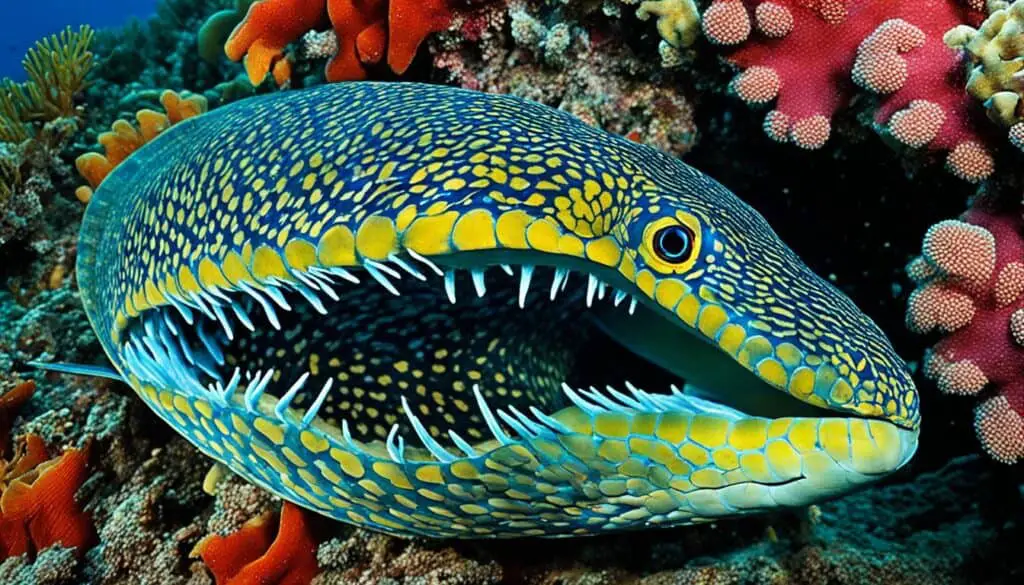Ever curious about how moray eels find their meals? These fascinating fish live in coral reefs worldwide. They have unique ways to hunt that are crucial for their survival. Let’s explore how moray eels hunt and what they eat, especially at night.
These fish have special skills that help them catch their prey. Their hunting methods show how important they are in the ocean. We’ll look into the amazing world of moray eels and their hunting skills.
Overview of Moray Eels
Moray eels are part of the Muraenidae family, with over 200 species. They are known for their long bodies. These fish don’t have pectoral or pelvic fins, making them stand out. Moray eels have different colors that help them blend in with their surroundings, like coral reefs and rocky places.
Most moray eels live in warm, tropical waters. But, some can be found in cooler areas too. They like living in coral reefs, rocky spots, and even in brackish waters. Their special features, like a strong sense of smell and sharp teeth, help them survive in these places.
It’s important to understand moray eels’ role in the ocean. They are both hunters and hunted, affecting their ecosystems.
| Characteristic | Details |
|---|---|
| Family | Muraenidae |
| Number of Species | Over 200 |
| Body Shape | Elongated, lacks pectoral and pelvic fins |
| Habitat | Tropical and temperate waters, often in coral reefs |
| Role in Ecosystem | Predator and prey |
Physical Adaptations for Hunting
Moray eels have evolved unique physical traits that boost their hunting skills. These traits greatly affect their hunting behavior, making them top predators under the sea. Their jaws are a key feature, with a main jaw and a secondary pharyngeal jaw. The main jaw grabs prey, and the pharyngeal jaw quickly moves it down to the esophagus. This setup lets moray eels eat fast, which is crucial in tight spaces like coral reefs.
Moray eels also have a sharp sense of smell, which helps them hunt. Since they don’t see well, their smell is key for finding prey in unclear waters or hidden spots. These traits show how nature shapes the survival tactics of predators.
| Adaptation | Description | Benefit |
|---|---|---|
| Unique Jaw Structure | Two sets of jaws for capturing and moving prey. | Facilitates rapid ingestion of prey. |
| Acute Olfactory Sense | Enhanced ability to smell. | Improves prey detection in low visibility. |
| Long, Flexible Body | Slender, elongated form suitable for maneuvering. | Allows navigation through tight spaces in reefs. |
How do moray eels hunt for food?
Moray eels have unique hunting methods that fit their body and their underwater world. They are skilled predators thanks to their special features.
Unique Jaw Structure
The jaws of moray eels are a big help in catching food. They have pharyngeal jaws that can quickly move towards their prey. This lets them hold onto their food better than many other fish.
This is very useful in tight spaces like coral reefs, where they often hide and surprise their prey.
Adaptations for Ambush
Being quiet is key for moray eels when they hunt. They lie still in their hiding spots, watching for prey. When prey comes close, they move fast to catch it off guard.
This way, they increase their chances of catching food. It shows how well moray eels have adapted to their hunting life.
| Adaptation | Function | Benefit |
|---|---|---|
| Pharyngeal Jaws | Rapid grip on prey | Enhanced predation efficiency |
| Stealthy Ambush | Remain motionless until the right moment | Maximized chances of successful capture |
| Camouflage | Blending into the reef environment | Increased surprise on unsuspecting prey |
Moray Eels Hunting Behavior
Moray eels have amazing hunting skills that help them catch prey. They are mostly active at night, coming out from their hiding spots as the sun sets. This way, they avoid competition with predators that are active during the day.
Nocturnal Hunting Patterns
Moray eels use their sharp sense of smell to find food at night. They can detect chemical signals from their prey in the dark waters. This skill lets them catch fish and invertebrates hiding in the shadows.
Their diet includes a variety of fish and crustaceans. They prefer to ambush their prey instead of chasing it. This ambush tactic saves energy and boosts their chances of catching food. They sneak up on their prey, staying still until the perfect moment to strike.

Learning about moray eels and their hunting ways is fascinating. Their unique adaptations and night-time hunting show how complex their survival strategies are. This makes them stand out in the marine world.
Cooperative Hunting with Groupers
Moray eels and groupers work together in hunting. This partnership makes hunting more successful for both. Morays can get into tight spaces to catch prey. Groupers are fast in open water, chasing down prey.
This teamwork boosts their hunting success. It shows how smart moray eels are at hunting.
Signal Communication
Good communication is key in hunting together. Groupers start the hunt with special head movements. These signals tell moray eels to join the chase.
This helps both species work together well. They can set up ambushes on different food sources.
Complementary Hunting Strategies
Moray eels and groupers use different skills to catch prey. Morays go into tight spots, while groupers push prey into the open. This teamwork helps them catch their prey easily.
By working together, they get more food and use their skills better. This shows the power of hunting together.
Diet and Feeding Habits of Moray Eels
Moray eels eat a wide variety of foods, showing their important role in the ocean. They like to eat different types of prey to survive in their underwater world.
Preferred Prey Types
Moray eels mainly eat:
- Fish
- Crustaceans
- Mollusks
- Occasionally scavenged marine animals
They have a varied diet because they are opportunistic eaters. They use their strong sense of smell to find food, especially in complex coral reefs.
Feeding Techniques
Moray eels have different ways to catch their food. Their main strategies are:
- Stealth and Ambush: They hide in rocks and coral to surprise their prey.
- Powerful Strikes: Their jaws are strong, letting them catch prey quickly and effectively.
- Cooperative Hunting: Sometimes, they hunt with groupers, making their hunting more successful.
These techniques help moray eels find and eat a wide range of food. This shows how adaptable they are in the ocean.
| Food Source | Description |
|---|---|
| Fish | Primary prey species, providing essential protein. |
| Crustaceans | Includes crabs and shrimp, rich in nutrients and widely available. |
| Mollusks | Such as octopus and clams, often targeted for their soft bodies. |
| Scavenged Animals | Helps in cleaning the reef, consuming weakened or deceased creatures. |
Impact of Environmental Factors on Hunting
Exploring moray eels’ hunting behavior shows how important environmental factors are. Water temperature changes their metabolism, affecting their hunger and hunting skills. In warm water, they hunt more often. But in cool water, they hunt less.
The shape of their home also changes how they hunt. Places with lots of nooks and crannies help them hide and catch prey. But in simple places, they can’t hide as well. They also need certain types of food, which can change if the environment does.
Other sea creatures can also affect their hunting. With more competition for food, moray eels might change how they hunt to survive. Studying these changes helps us understand moray eels better. It also helps us protect the ocean and its balance.
FAQ
How do moray eels hunt for food?
Moray eels hunt at night using their special jaws to catch prey fast. They lie still until prey comes close, then they strike very quickly.
What are the primary food sources for moray eels?
Moray eels eat fish and invertebrates like crustaceans and mollusks. They can also eat weakened or dead marine animals if they need to.
How do environmental factors affect moray eel hunting behavior?
Things like water temperature, how complex their habitat is, and how much prey is around affect how moray eels hunt. These things can change how they hunt at night and what prey they can get.
What role do cooperative hunting strategies play in moray eels’ survival?
Moray eels work together with groupers to hunt. Groupers chase prey in open water, and morays ambush from tight spots. This teamwork helps them catch more prey.
How do moray eels use scent to locate food?
Moray eels use their strong sense of smell to find prey in coral reefs. This helps them since they don’t see very well. It makes finding food easier for them.
What are some common hunting techniques employed by moray eels?
Moray eels use sneaky ambush tactics and quick strikes to catch prey. Their jaws help them grip and swallow prey fast, especially in tight spots.
Do moray eels have any predators?
Yes, bigger fish and some marine mammals eat moray eels. Their hunting and living places help them avoid being eaten, especially at night.







